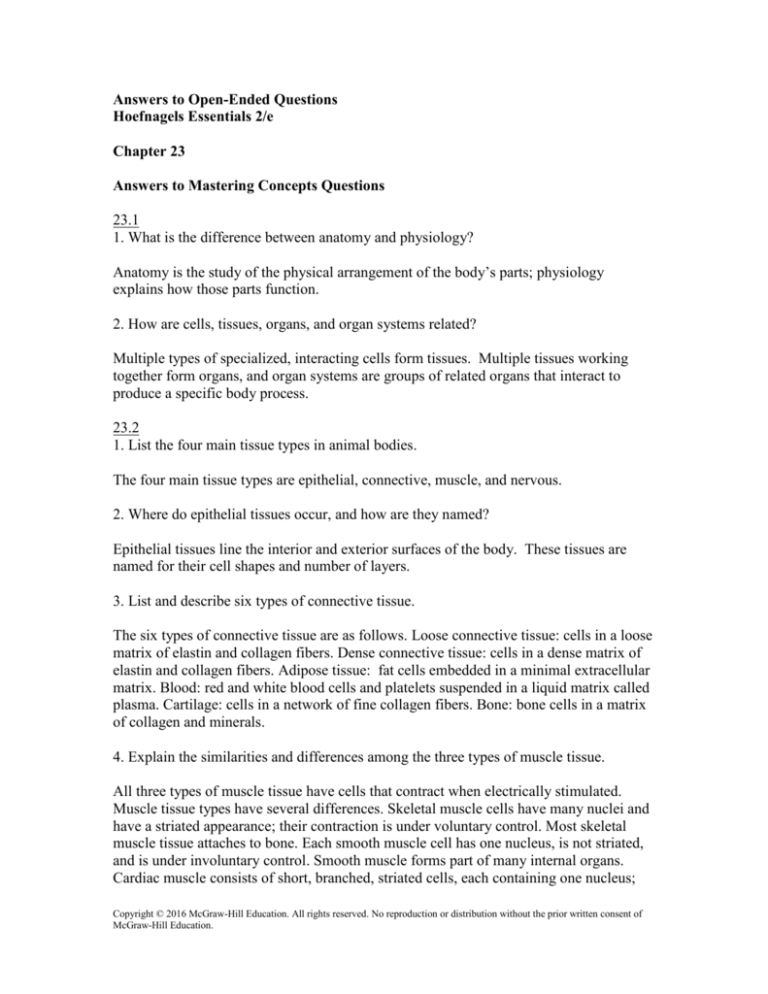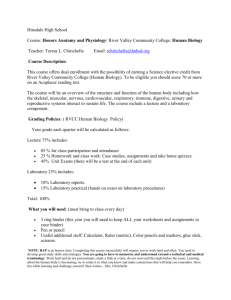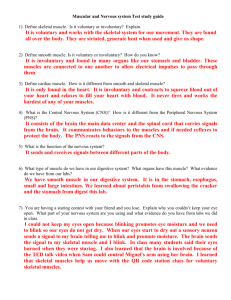
Answers to Open-Ended Questions
Hoefnagels Essentials 2/e
Chapter 23
Answers to Mastering Concepts Questions
23.1
1. What is the difference between anatomy and physiology?
Anatomy is the study of the physical arrangement of the body’s parts; physiology
explains how those parts function.
2. How are cells, tissues, organs, and organ systems related?
Multiple types of specialized, interacting cells form tissues. Multiple tissues working
together form organs, and organ systems are groups of related organs that interact to
produce a specific body process.
23.2
1. List the four main tissue types in animal bodies.
The four main tissue types are epithelial, connective, muscle, and nervous.
2. Where do epithelial tissues occur, and how are they named?
Epithelial tissues line the interior and exterior surfaces of the body. These tissues are
named for their cell shapes and number of layers.
3. List and describe six types of connective tissue.
The six types of connective tissue are as follows. Loose connective tissue: cells in a loose
matrix of elastin and collagen fibers. Dense connective tissue: cells in a dense matrix of
elastin and collagen fibers. Adipose tissue: fat cells embedded in a minimal extracellular
matrix. Blood: red and white blood cells and platelets suspended in a liquid matrix called
plasma. Cartilage: cells in a network of fine collagen fibers. Bone: bone cells in a matrix
of collagen and minerals.
4. Explain the similarities and differences among the three types of muscle tissue.
All three types of muscle tissue have cells that contract when electrically stimulated.
Muscle tissue types have several differences. Skeletal muscle cells have many nuclei and
have a striated appearance; their contraction is under voluntary control. Most skeletal
muscle tissue attaches to bone. Each smooth muscle cell has one nucleus, is not striated,
and is under involuntary control. Smooth muscle forms part of many internal organs.
Cardiac muscle consists of short, branched, striated cells, each containing one nucleus;
Copyright © 2016 McGraw-Hill Education. All rights reserved. No reproduction or distribution without the prior written consent of
McGraw-Hill Education.
the cells are connected electrically so that they contract simultaneously. Cardiac muscle
forms much of the heart and is under involuntary control.
5. What are the two main cell types in nervous tissue?
The two main cell types in nervous tissue are neurons and neuroglia.
23.3
1. Which organ systems contribute to each of the five general functions of life?
The five general functions of life and the corresponding organ systems are:
communication (nervous and endocrine systems); movement and support (muscular and
skeletal systems); acquiring energy (circulatory, respiratory, and digestive systems);
protection (urinary, integumentary, and immune/lymphatic systems); reproduction
(reproductive system, although all other systems contribute indirectly to this function).
2. What are three examples of interactions between organ systems?
Answers may vary, but here are three examples. (1) The circulatory system brings blood
to the urinary system, where the chemical composition of the blood is adjusted. The
functions of the urinary system are controlled by hormones produced by endocrine
glands. (2) The respiratory system exchanges gases with the atmosphere. The nervous
system works with the endocrine system to control the breathing rate; voluntary and
involuntary muscles enable breathing to occur. (3) The digestive system breaks food into
particles that are absorbed into the bloodstream and carried to cells that need nutrients.
The digestive system is controlled by hormones and influenced by the nervous system,
and muscles propel food along the digestive tract.
23.4
1. Use figure 23.7 to explain which materials enter and exit the body, and how they do so.
Food and water enter the digestive tract through the mouth. Most nutrients and water are
absorbed into the bloodstream, but feces (undigested food) leaves the body through the
anus. Oxygen enters the body, and carbon dioxide leaves the body, at the lungs. Heat
leaves the body through the skin. Metabolic wastes and excess water, salts, and nutrients
pass from the circulatory system into the urinary system, which combines these
substances into urine that leaves the body.
2. What happens to an organism that fails to maintain homeostasis?
An organism that fails to maintain homeostasis will stop functioning and will eventually
die.
3. Distinguish between negative and positive feedback.
Copyright © 2016 McGraw-Hill Education. All rights reserved. No reproduction or distribution without the prior written consent of
McGraw-Hill Education.
In negative feedback, the body reacts to a change by triggering action that reverses the
change. In positive feedback, the body reacts to a change by amplifying the change.
23.5
1. Describe the difference between endotherms and ectotherms.
Endotherms regulate their body temperature through internal mechanisms. Ectotherms
use the environment, not their own internal mechanisms, to regulate their body
temperature.
2. What are the advantages and disadvantages of endothermy and ectothermy?
Ectothermy requires less food and oxygen than endothermy. One disadvantage of
ectothermy, however, is that an animal must be able to move to an appropriate area to
raise or lower its body temperature. Ectotherms also become sluggish at low
temperatures. Endotherms are typically more active animals, especially at low
temperatures, but they require much more food and oxygen than do ectotherms.
Write It Out
1. Distinguish between:
a. organs and organ systems.
b. simple squamous and stratified squamous epithelial tissue.
c. loose and dense connective tissue.
d. skeletal and cardiac muscle tissue.
e. neurons and neuroglia.
f. negative and positive feedback.
(a) Organs are the individual structures that function together to make up an organ
system. (b) Simple squamous epithelium includes just one layer of cells; stratified
squamous epithelial tissue contains more than one layer of cells. (c) Loose connective
tissue binds tissues together and fills spaces, whereas dense connective tissue builds
ligaments and tendons. (d) Skeletal muscle tissue is voluntary and has long cells,
whereas cardiac muscle is involuntary and consists of electrically connected, short,
branched cells. (e) Neurons are the communicating cells of the nervous system, whereas
neuroglia are the supporting cells. (f) Negative feedback maintains homeostasis by
reversing the effects of a change; positive feedback counters homeostasis by amplifying a
change.
2. Use the Internet to research cosmetic surgery. Write a paragraph explaining how a
plastic surgeon might manipulate each of the four main tissue types.
[Many examples are possible; two examples are provided here.] (1) During a facelift,
mostly epithelial and connective tissue are rearranged. A plastic surgeon cuts through the
skin, detaches it from the underlying muscle, removes excess skin, and reattaches it to the
Copyright © 2016 McGraw-Hill Education. All rights reserved. No reproduction or distribution without the prior written consent of
McGraw-Hill Education.
face. (2) Smile reconstruction surgery moves muscle and nerve tissue from another part
of the body to the face, allowing patients with partial face paralysis to smile again.
3. Explain how you use your organ systems (except your reproductive system) while you
are exercising at the gym, and provide three hypotheses that might explain why identical
workouts might feel easier on some days than others.
Nervous system: stimulates muscles to contract. Endocrine system: releases hormones
that make pain more tolerable. Skeletal system and muscular system: muscles pull on
bones to move body parts. Digestive system: breaks down food to provide energy for
movement. Circulatory system: pumps oxygen-rich blood to muscles, and carries carbon
dioxide away from muscles. Respiratory system: exchanges oxygen and carbon dioxide
between the atmosphere and the blood. Urinary system: collects nitrogenous wastes
produced at muscles. Integumentary system: regulates water loss through the skin.
Immune system: protects against bacteria on workout equipment. A workout might be
more successful if the respiratory system is free of obstructions, such as mucus; if the
digestive system has recently extracted nutrients from food; and if the muscles have not
been overworked in previous sessions.
4. Describe how the circulatory system connects the digestive system with the urinary
system.
Nutrients and water move from the digestive system into the circulatory system, which
carries these substances to body tissues. Excess water and nutrients move from the
circulatory system into the urinary system and are excreted in urine.
5. Make a chart that compares and contrasts the organization of the animal body with that
of a plant (see chapter 21).
Cells: Animals have many specialized cell types; plants have fewer specialized cell types.
Tissues: Animal tissue types are epithelial, connective, muscle, and nervous tissues; plant
tissue types are ground tissue, dermal tissue, and vascular tissue. Organs: Animals have
many organs; plants have vegetative organs (roots, stems, and leaves) and reproductive
organs (fruits, flowers, and seeds). Organ systems: Animals have several organ systems
(nervous, endocrine, skeletal, muscular, digestive, circulatory, respiratory, urinary,
integumentary, immune, lymphatic, and reproductive); plants have two organ systems
(roots and shoots).
6. What is homeostasis, and how is it important?
Homeostasis is a state of internal constancy. Cells and tissues must have conditions
within a certain range if they are to function. If the body system cannot maintain
homeostasis, it may stop functioning, and the organism may die.
Copyright © 2016 McGraw-Hill Education. All rights reserved. No reproduction or distribution without the prior written consent of
McGraw-Hill Education.
7. Provide nonbiological examples of negative and positive feedback, other than those
mentioned in the chapter.
Answers will vary; here are two examples. Most people adjust spending by negative
feedback. After a big paycheck, spending increases, whereas after a large expense,
spending decreases. The transition from swiftly moving traffic to a traffic jam is an
example of positive feedback. When one person slams on the brakes, for example, the car
behind must also brake, and so on.
8. When a person gets cold, he or she may begin to shiver. If the weather is too hot, the
heart rate increases and blood vessels dilate, sending more blood to the skin. How does
each scenario illustrate homeostasis?
Both examples illustrate how the body maintains a constant temperature. Shivering is the
involuntary contraction of skeletal muscles; the muscle movement produces heat, which
helps increase the body temperature. In the second scenario, blood passing near the skin
surface releases heat to the atmosphere, which helps cool the overheated body.
9. Observe what happens to the size of your eye’s pupil when you leave a dark room and
enter the sunshine. What happens in the opposite situation, when you enter a dark room?
How do the opposing reactions of your eye illustrate negative feedback?
When the light levels reaching the eye’s sensory cells are very high, the pupil constricts.
This lets in less light and counters the original stimulus. If you enter a dark room where
less light reaches the eye, then the pupil will dilate. This change will let in more light and,
again, counters the original stimulus.
10. Birds and insects frequently collect nectar from plants. Birds are endothermic, and
insects are ectothermic. Do you think a greater mass of insects or of birds can be
supported on 100 g of nectar? Explain your answer.
A given amount of nectar supports a greater mass of insects than birds because
ectotherms use less energy and therefore require less food than do endotherms.
11. Would an alligator require more, less, or the same amount of food as a horse of the
same size? Explain.
Because it is ectothermic, an alligator would need less food than a horse of the same size.
The horse requires extra food to generate the energy needed to maintain a constant body
temperature.
12. Woolly mammoths are extinct relatives of modern-day elephants. The mammoths
were heavier and shaggier than elephants, their ears were smaller, and they had a thick fat
layer under their skin. Explain each of these differences in light of the fact that today’s
elephants originate in Asia and Africa, whereas mammoths lived on the tundra.
Copyright © 2016 McGraw-Hill Education. All rights reserved. No reproduction or distribution without the prior written consent of
McGraw-Hill Education.
On the tundra, the temperatures are much colder than they are in Asia and Africa. The
mammoths’ extra body mass reduced the surface area relative to the animal’s volume,
reducing heat loss to the environment. Fat and the shaggy coat added insulation. The
smaller ears meant less surface area for heat loss.
Pull It Together
1. Add the specific types of epithelial, connective, muscle, and nervous tissue to this
concept map.
“Epithelial” connects with “includes” to “Simple squamous,” “Simple cuboidal,” “Simple
columnar,” and “Stratified squamous.” “Connective” connects with “includes” to “Loose
connective tissue,” “Dense connective tissue,” “Adipose tissue,” “Blood,” “Cartilage,”
and “Bone”. “Muscle” connects with “includes” to “Skeletal muscle”, “Cardiac muscle”,
and “Smooth muscle.” “Nervous” connects with “includes” to “Neurons” and
“Neuroglia.”
2. Add the names of the 11 organ systems to this concept map.
In the answer below, all connections include the phrase “is carried out by.”
“Communication” connects to “Nervous system” and “Endocrine system.” “Support and
movement” connects to “Skeletal system” and “Muscular system.” “Energy acquisition”
connects to “Digestive system,” “Circulatory system,” and “Respiratory system.”
“Reproduction” connects to “Reproductive system.” “Protection” connects to “Urinary
system,” “Integumentary system,” and “Immune/Lymphatic system.”
3. Add thermoregulation to the concept map and connect it to as many organ system
functions as possible.
“Communication” connects with “systems detect temperature changes and initiate
mechanisms of” to “thermoregulation.” “Energy acquisition” connects with “systems are
essential to providing the energy endotherms use in” to “thermoregulation.” “Protection”
connects with “systems insulate and allow evaporative cooling, providing mechanisms
of” to “thermoregulation.” “Support and movement” connects with “systems allow
animals to move to appropriate environments for” to “thermoregulation.” “Support and
movement” connects with “systems produce heat that is used in” to “thermoregulation.”
4. Describe examples of organ system interactions that maintain homeostasis.
[Many answers are possible.] Organ systems interact in a variety of ways to maintain
homeostasis. For example, the brain monitors blood pressure. If blood pressure becomes
too high, then the brain sends signals to the heart to slow its rate of contraction. The brain
also detects changes in temperature. If the body becomes too cold, then the brain signals
the muscles to begin shivering, which releases heat into the nearby blood vessels.
Copyright © 2016 McGraw-Hill Education. All rights reserved. No reproduction or distribution without the prior written consent of
McGraw-Hill Education.










